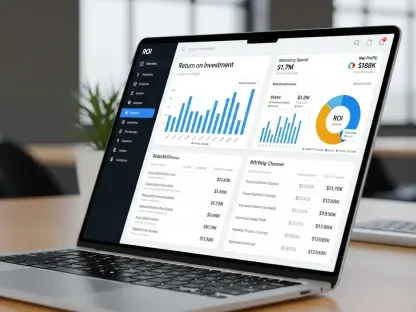This guide aims to equip retail leaders and investors with actionable strategies to navigate the challenging tariff landscape of 2025, helping them build resilience against economic shocks and policy shifts. By adopting ecosystem-driven approaches, retailers can transform tariff woes into opportunities for growth, ensuring financial stability and market dominance in a fragmented global environment. The following steps and insights provide a clear path to mitigating risks and thriving amid uncertainty.
Tariff Turbulence: Why Retail Strategies Matter Now More Than Ever
In the current economic climate, tariffs have emerged as a formidable obstacle for the retail sector, with an average effective rate of 18.3% in the U.S., as reported by the Yale Budget Lab, placing unprecedented pressure on profit margins. Retailers face escalating costs on imported goods, disrupting supply chains and squeezing consumer spending power. This scenario demands a strategic overhaul, as clinging to outdated models risks severe financial setbacks in a market defined by volatility.
The divergence between traditional, cost-driven retail frameworks and innovative, ecosystem-based strategies has never been more pronounced. While conventional models falter under the weight of sudden cost increases, businesses leveraging diversified operations and adaptive systems are gaining ground. Ecosystem approaches prioritize resilience, enabling firms to absorb shocks through multiple revenue streams and agile operations.
Setting the stage for survival, strategic adaptation stands as a cornerstone for retailers navigating a splintered global market. With trade policies shifting rapidly, the ability to pivot and innovate separates thriving enterprises from those struggling to keep pace. Embracing resilience through comprehensive strategies is no longer optional but essential for long-term success in this turbulent landscape.
The Cost of Complacency: Tariffs Expose Retail Vulnerabilities
The current U.S. tariff environment poses a significant threat to retailers reliant on low-cost imports, with the high effective rate amplifying operational expenses. Many companies built on linear, price-sensitive models find themselves exposed, unable to absorb the financial strain of increased import duties. This vulnerability has been starkly revealed as policy changes reshape the competitive arena.
Specific examples, such as Temu and Shein, illustrate the pitfalls of over-reliance on cost-driven approaches. These platforms, heavily dependent on Chinese imports, have faced steep challenges, with Temu cutting advertising budgets drastically and witnessing a plummet in Google Shopping ad impressions, while Shein has paused ad campaigns awaiting tariff relief. Such struggles highlight the fragility of business models lacking flexibility or diversified income sources.
Moreover, the termination of the de minimis exemption for low-value imports has compounded these issues, forcing significant price hikes and ad spend reductions. For instance, Temu raised prices by 40%, triggering a 38% drop in advertising investment, underscoring how rigid frameworks crumble under sudden regulatory shifts. Retailers ignoring the need for strategic evolution risk obsolescence in an era where adaptability dictates survival.
Building Resilience: How Ecosystem Strategies Outperform in Crisis
Ecosystem-driven strategies offer a robust shield against tariff shocks by integrating multiple operational layers that enhance stability. Unlike linear models, these approaches distribute risk across various channels, ensuring that a setback in one area does not derail the entire business. Retailers adopting this mindset can turn economic challenges into competitive advantages through deliberate, multi-faceted planning.
The following steps outline how to construct such resilience, focusing on diversification, agility, data optimization, and network effects. Each component addresses a specific vulnerability exposed by tariffs, creating a comprehensive framework for enduring market disruptions. By implementing these strategies, retailers can safeguard operations and position themselves for growth.
Step 1: Diversifying Revenue Streams for Financial Stability
The first critical step involves diversifying revenue sources to insulate against economic volatility. Companies like Amazon exemplify this by generating income from retail, cloud computing, and advertising, ensuring that a downturn in one sector does not cripple overall performance. This approach provides a financial buffer, allowing businesses to weather tariff-induced cost spikes without drastic cuts.
Beyond Retail: The Power of Cross-Sector Income
Expanding into cross-sector income reduces dependency on single markets or suppliers, a key factor in maintaining stability. When tariffs disrupt import-heavy operations, revenue from unrelated sectors can sustain cash flow, offering breathing room to adapt. Retailers should explore opportunities beyond traditional sales, such as subscription services or technology solutions, to build a more resilient financial foundation.
Step 2: Harnessing Supply Chain Agility to Mitigate Risks
A second vital step is cultivating supply chain agility to minimize the impact of tariff-heavy imports. By forging domestic manufacturing partnerships and adopting nearshoring practices, retailers can reduce exposure to international trade barriers. This shift not only mitigates cost increases but also enhances responsiveness to sudden market changes.
Localizing Production: A Shield Against Global Disruptions
Localizing production acts as a powerful defense against global disruptions, cutting both costs and delivery times. Proximity in supply chains enables faster adaptation to policy shifts, ensuring that retailers are not caught off guard by new tariffs or trade restrictions. Partnering with regional suppliers strengthens operational control and builds a more sustainable sourcing model.
Step 3: Leveraging Data and Technology for Real-Time Optimization
The third step focuses on harnessing data and technology to enable real-time decision-making in pricing and inventory management. Amazon’s 29% increase in Prime Video ad spend demonstrates how performance-based advertising, driven by data, can optimize returns even in turbulent times. Retailers must invest in tools that provide actionable insights to stay ahead of market fluctuations.
Dynamic Pricing: Turning Volatility into Opportunity
Dynamic pricing, supported by AI-driven forecasting and analytics, transforms volatility into opportunity by adjusting costs based on demand and supply trends. This capability allows retailers to respond swiftly to tariff impacts, maintaining profitability without alienating customers. Implementing such systems ensures that pricing strategies remain competitive and adaptable under pressure.
Step 4: Capitalizing on Network Effects for Market Dominance
The final step is leveraging network effects through integrated ecosystems to secure market dominance. Platforms like Amazon’s Demand-Side Platform illustrate how logistics networks and retail media amplify reach and efficiency. Building interconnected systems creates a compounding advantage that competitors struggle to match during economic uncertainty.
Ecosystem Synergies: Amplifying Growth Amid Challenges
Ecosystem synergies amplify growth by linking various business functions, from supply chains to marketing, into a cohesive unit. This integration strengthens market position as each component reinforces the others, driving customer loyalty and operational scale. Retailers prioritizing such networks can navigate tariff challenges with greater confidence and sustained expansion.
Key Takeaways: Core Pillars of Retail Resilience
The essential strategies for overcoming tariff challenges can be distilled into a concise framework for action:
- Diversify revenue streams to reduce financial risk and ensure stability across market shifts.
- Build agile supply chains through localization and partnerships to minimize exposure to global trade barriers.
- Utilize real-time data for adaptive pricing and inventory control, maintaining competitiveness in volatile conditions.
- Develop integrated ecosystems to create sustainable competitive edges that withstand economic pressures.
Looking Ahead: Ecosystem Strategies in a Shifting Retail Landscape
Ecosystem-driven approaches are increasingly recognized as the benchmark for retail success amid ongoing economic fragmentation. These strategies provide a structural advantage, enabling companies to pivot effectively as trade policies evolve. Retailers embracing this model are better equipped to handle disruptions and capitalize on emerging opportunities.
Future challenges, such as potential policy reversals like the U.S. Court of International Trade’s ruling in May of this year on past tariff measures, underscore the need for vigilance. Unpredictable regulatory changes can upend even well-planned operations, making flexibility a critical asset. Staying informed and prepared for such shifts remains a priority for sustained performance.
For investors, the focus should be on supporting companies with adaptability, diversified models, and robust contingency plans. Backing firms that demonstrate resilience through ecosystem integration offers a safer bet in an uncertain market. Evaluating potential investments based on these criteria can help navigate the complexities of the current retail environment.
Final Thoughts: Choosing Resilience in an Uncertain Market
Reflecting on the journey through tariff challenges, it becomes evident that resilience is a deliberate choice forged through strategic planning rather than a passive outcome. Retailers and investors who embrace ecosystem-building over short-term cost-cutting lay a stronger foundation for enduring success. The path taken highlights the power of adaptability in turning economic hurdles into stepping stones.
Looking back, the commitment to diversified revenue, agile supply chains, data-driven decisions, and integrated networks proved transformative. For those moving forward, the next step lies in continuously refining these strategies to anticipate future disruptions. Exploring partnerships and technologies that enhance operational flexibility can further solidify market standing.
Beyond immediate tactics, a broader consideration emerges around fostering innovation as a response to uncertainty. Stakeholders who support firms treating tariffs as catalysts for creative solutions position themselves at the forefront of retail evolution. This mindset of proactive adaptation remains the guiding principle for navigating whatever challenges lie ahead in the ever-shifting global landscape.









